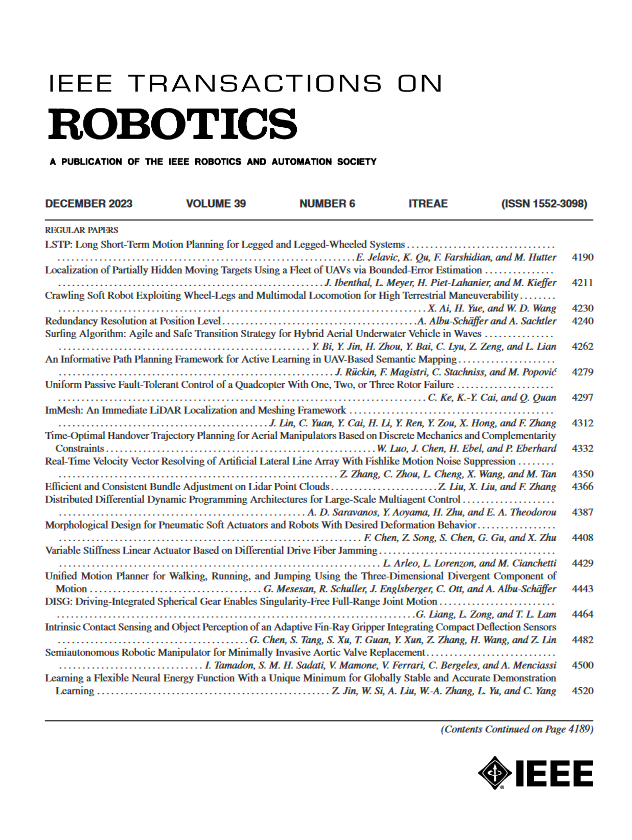学习用多感官集成软手操纵薄的可变形物体
IF 10.5
1区 计算机科学
Q1 ROBOTICS
引用次数: 0
摘要
机器人操作已经取得了重大进展,系统显示出高精度和可重复性。然而,这种卓越的精度往往不能转化为薄的可变形物体的有效操作。目前的机器人系统缺乏不精确的灵巧性,即通过鲁棒性和自适应行为来执行灵巧操作的能力,而不依赖于精确的控制。本文探讨了对薄的、可变形的物体的模拟和抓取。在这里,我们提出了一种新的解决方案,将被动顺应,触摸和本体感觉结合到薄的,可变形的物体操作中。我们的系统采用柔软的、欠驱动的手,提供被动顺应,促进自适应和温和的交互,灵活地操纵可变形的物体,而不需要精确的控制。配备在手上的触觉和力/扭矩传感器,以及一个深度摄像头,通过拟议的滑动模块收集操作所需的感官数据。操作策略通过无模型强化学习直接从原始感官数据中学习,绕过显式环境和对象建模。通过对动作空间的解耦,实现了分层双环学习过程,提高了学习效率。我们的方法被部署在现实世界的机器人上,并以一种自我监督的方式进行训练。最终的策略在各种具有挑战性的任务中进行了测试,这些任务超出了之前的研究的能力,从像销售人员一样展示西装面料到为小提琴家翻页乐谱。本文章由计算机程序翻译,如有差异,请以英文原文为准。
Learning Thin Deformable Object Manipulation With a Multisensory Integrated Soft Hand
Robotic manipulation has made significant advancements, with systems demonstrating high precision and repeatability. However, this remarkable precision often fails to translate into efficient manipulation of thin deformable objects. Current robotic systems lack imprecise dexterity, the ability to perform dexterous manipulation through robust and adaptive behaviors that do not rely on precise control. This article explores the singulation and grasping of thin, deformable objects. Here, we propose a novel solution that incorporates passive compliance, touch, and proprioception into thin, deformable object manipulation. Our system employs a soft, underactuated hand that provides passive compliance, facilitating adaptive and gentle interactions to dexterously manipulate deformable objects without requiring precise control. The tactile and force/torque sensors equipped on the hand, along with a depth camera, gather sensory data required for manipulation via the proposed slip module. The manipulation policies are learned directly from raw sensory data via model-free reinforcement learning, bypassing explicit environmental and object modeling. We implement a hierarchical double-loop learning process to enhance learning efficiency by decoupling the action space. Our method was deployed on real-world robots and trained in a self-supervised manner. The resulting policy was tested on a variety of challenging tasks that were beyond the capabilities of prior studies, ranging from displaying suit fabric like a salesperson to turning pages of sheet music for violinists.
求助全文
通过发布文献求助,成功后即可免费获取论文全文。
去求助
来源期刊

IEEE Transactions on Robotics
工程技术-机器人学
CiteScore
14.90
自引率
5.10%
发文量
259
审稿时长
6.0 months
期刊介绍:
The IEEE Transactions on Robotics (T-RO) is dedicated to publishing fundamental papers covering all facets of robotics, drawing on interdisciplinary approaches from computer science, control systems, electrical engineering, mathematics, mechanical engineering, and beyond. From industrial applications to service and personal assistants, surgical operations to space, underwater, and remote exploration, robots and intelligent machines play pivotal roles across various domains, including entertainment, safety, search and rescue, military applications, agriculture, and intelligent vehicles.
Special emphasis is placed on intelligent machines and systems designed for unstructured environments, where a significant portion of the environment remains unknown and beyond direct sensing or control.
 求助内容:
求助内容: 应助结果提醒方式:
应助结果提醒方式:


